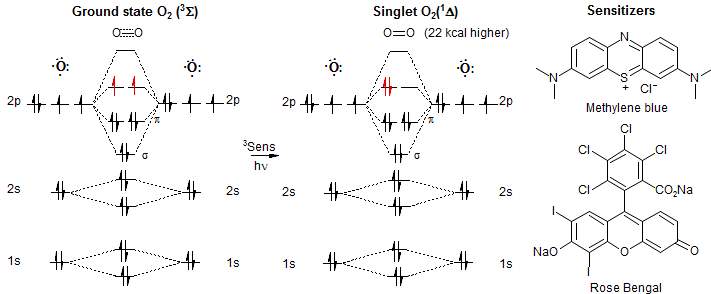Singlet Oxygen
The Schenck Ene Reaction: Diastereoselective Oxyfunctionalization with Singlet Oxygen in Synthetic Applications,
Prein, M.; Adam, W. Angew. Chem. Int. Ed. Engl. 1996, 35, 477-94.
Regioselectivity in the Ene Reaction of Singlet Oxygen with Alkenes,
Stratakis, M.; Orfanopoulos, M. Tetrahedron 2000, 56, 1595-615.
New Mechanistic and Synthetic Aspects of Singlet Oxygen Chemistry,
Clennan, E. L. Tetrahedron 2000, 56, 9151-79.
Singlet oxygen (1Δ O2, 22 kcal/mol higher in energy) can be generated by shining light on a solution of oxygen in the presence of a triplet sensitizer like Methylene Blue or Rose Bengal. There are also several chemical methods of generating singlet oxygen, most notably the reaction of hydrogen peroxide with hypochlorite.

The triplet ground state of dioxygen (3Σ O2) can be considered to have two half-double bonds, whereas the singlet excited state (1Δ O2) has a true π bond. There is also a second excited state, a singlet where the two electron are in separate orbitals, but spin paired (the 1Σ state, 37 kcal/mol above ground state). Not much is known about its chemical reactivity. (diatomic orbital diagrams)

Singlet oxygen has a lifetime of under a second, but it is very much more reactive towards organic compounds than is triplet oxygen, reacting readily with alkenes (ene reaction to form allylic hydroperoxides), dienes (cycloaddition to form 1,2-dioxanes), electron-rich aromatic compounds, phosphines, sulfides and selenides (to form oxides). Singlet oxygen is an electrophilic reagent (note the low-energy LUMO), and reacts more readily with electron rich double bonds, and slowly or not at all with electron poor ones. Note that all these reactions must happen during the short lifetime of singlet oxygen before it decays to the ground state.

Note that the singlet oxygen ene reaction corresponds to an allylic oxidation with migration of the double bond, analogous to the sequence epoxidation, elimination. The SeO2 oxidation of alkenes, on the other hand, leads to allylic oxidation with retention of double bond position. Radical chain oxidations will typically lead to mixtures of rearranged and unrearranged products from nonselective trapping of the intermediate allyl radical

Allylic hydroxylation, conversion of a diene to furan. Dendrolasin: Kondo, K.; Matsumoto, M. Tetrahedron Lett.. 1976, 391. DOI

Conversion of a furan to a hydroxy-butenolide. Dysidiolide: Madnuson, S. R.; Sepp-Lorenzino, L.; Rosen, N.; Danishefsky, S. J. J. Am. Chem. Soc. 1998, 120, 1615. DOI

Conversion of cyclopentadiene to a hydroxycyclopentenone. 15-Deoxyprostagladin E1: Sih, C. J.; Salomon, R. G.; Price, P.; Peruzzoti, G.; Sood, R. Chem. Commun. 1972, 240 DOI
